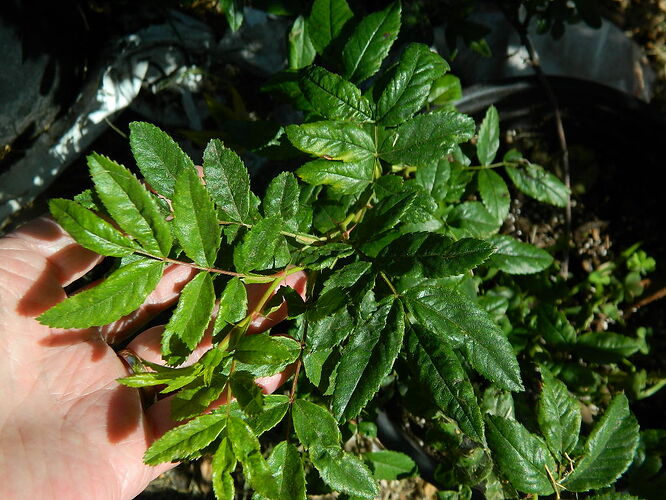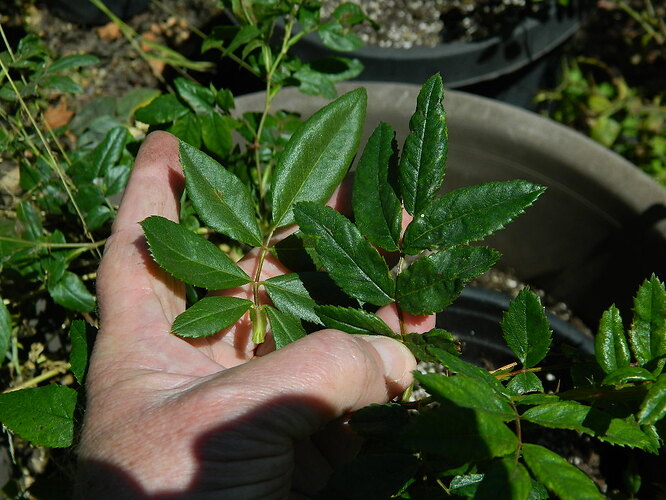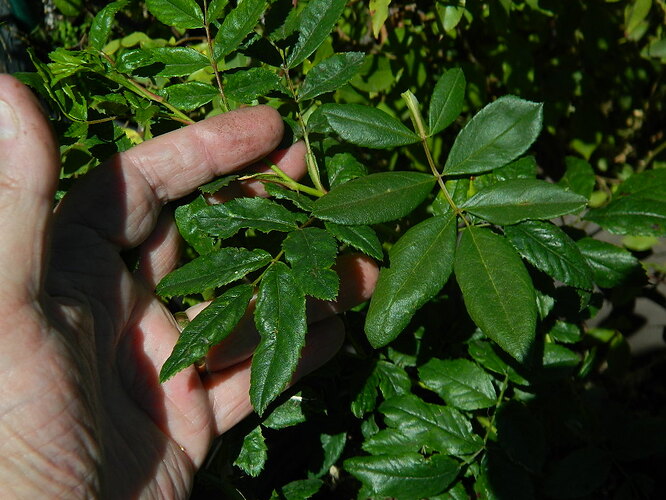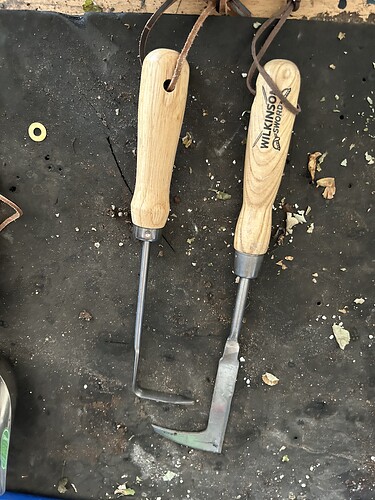I can’t remember whom I traded R. foliolosa for a species rose that is growing in some shade. I can remember that the trade came from Richmond, Virginia-- hence my confusion with R. virginiana. But then at that time, I was trying R. carolina and Swamp Rose. I am sure that it is either virginiana or carolina. Maybe someone can help. The foilage is long and willowy, not unlike R. foliolosa, but a little more stout. And there are numerious amount of thorns. I will send pics tommorow of buds and leaves. It has spread to make a 2 foot suckering bush, 2 foot high. And the flowers are a lovely shade of pinky lavender. It blooms fairly late. It is barely blooming now.
I think this may have come from Paul Olsen, but I haven’t heard him for a little while.
Here a pictures. I’m pretty sure it’s virginiana.
Link: forums.gardenweb.com/forums/load/rosesname/msg0720445819850.html
It looks like virginiana to me. But I’ve never seen carolina so I might be mistaken if they two are very similar. Your description sounds like virginiana – only a lot smaller than any I have seen. But it does bloom very late and suckers like mad.
Yeah, it does bloom pretty late… I wanted to cross it with foliolosa as the pollen parent, but foliolosa is already done. I’ve saved pollen for next year. It’s still new, and suckering a lot.
I am looking for an experienced connoisseur of both R. virginiana and R. carolina. It is clear to me that they are difficult to distinguish, but I am still looking for the one characteristic that separates them. I have Rosa virginiana in cultivation and the second one, perhaps R.carolina, I discovered last weekend at a former air base site. What was particularly eye-catching to me was the still blooming behavior. R. virginiana has finished its blooming season already. The red tinted stipules were completely absent. Also the habitus was somewhat different. But maybe the difference corresponds to the natural variation of the same variety in a different habitat. Who can help?
I’ve never actually seen either Carolina nor Virginiana but here are D’Orsay and Basye’s Legacy foliage. Both are hybrids of Carolina and have a lot of similarity to each other.
D’Orsay
Legacy on the left, D’Orsay on the right
D’Orsay on the left, Legacy on the right.
D’Orsay on the left, Legacy on the right.
Figure 5 in this paper shows the relationship of virginiana to carolina from an evolutionary perspective. Based on this relationship I would guess that it is virtually impossible to distinguish one from the other based on leaf morphology and probably impossible even with an identification key, if such a key exists.
Polyploid and hybrid evolution in roses east of the Rocky Mountains
The distinguishing feature of my Rosa virginiana was the last inch or two of the roots. They seemed to be specially reinforced for boring through soil having sort of a blunted club shape. I don’t know if carolina shares this feature but it is highly effective. I eventually turfed out my copy of virginiana because I couldn’t afford to build a concrete basin to contain it.
I will say that virginiana would make a very productive starting point for hybridization. It has very attractive foliage that is nearly bulletproof against disease in my climate and winter here (5b) didn’t phase it. It is tetraploid and I got a lot of successful crosses out of it though I didn’t pursue them. The downside is the prickles and the propensity to spread underground.
Joe Bergeson has established some pretty interesting lines from virginiana.
It’s quite possible that your rose is R. carolina, but it can be quite difficult to distinguish the two tetraploid species, which are both postulated to be ancient hybrids with overlapping diploid species ancestry, without examining certain features up close.
This might be helpful (see the dichotomous key on page 833): https://www.plantevolution.org/pdf/Joly&Bruneau_2007_SystBot.pdf
Some further reading: https://bsapubs.onlinelibrary.wiley.com/doi/10.3732/ajb.93.3.412
Stefan
I am still enjoying green and giant slug hunting over the puddle in SIL rose garden so can’t get you photos for awhile of a number vendor labelled Carolina and Virginiana in my Canadian garden. Though swore l saw one of the two at Kew.
Only unreliable diagnostics l use is height and bloom size, as mentioned before, which has remained very different for 10-15 years between the two types.
Carolina 30- 50% taller. Virginiana at or slightly above knee level. Carolina bloom larger. Does u no good until later or u find a standard for comparison. Don’t study foliage prickles or canes but will give it a look see later.
Had one Virginiana sport to plena after a few years, the whole bush??? Its remained stable and doesn’t appear to grow as well “in my garden” after sporting.
Thank you all. I see, so I have to accept that a correct determination is not possible in the classical way. If it could be possible at all, it would probably require greater and more extensive efforts.
N.B. The supplementary literature references are also very informative. Thanks for sharing.
Riku, now, that is the exact opposite of what R. carolina and R. virginiana generally do elsewhere! Maybe if your R. carolina is from hardier stock than your R. virginiana and is a lot happier, that could make some kind of sense. Otherwise, R. virginiana is much taller and has larger canes than R. carolina. Looking at the prickles, stipules and auricles should be more helpful if their sizes are off for some reason.
Stefan
Interesting, made it back yesterday hassle free, probably due to dual nationalities slide and trusted traveller security clearance. Explains why woke up 3:30 am.
Lots of legal garden tools of superior continental manufacturing and pleasing robust ergonomic design and materials - l like stainless steel.
Three varieties of meconopsis seeds from favourite Chelsea medalled nursery - another this year- tough again to germinate but grow well in garden when l get it right, but not evasive - one commonly available here. But wrong twist of trowel or soil depth or recharging or new neighbours and they are gone as has happened more than once.
I’’ll have a detailed look at the Kew photos and see if l did take one. Though l would be assuming they got it right - somebody must of id it right in the world. Debate is good but without a definite visible above surface physical difference and recognized Parisian metre bar visible standard eqivalent on the horizon l naturally defer to Don Quixote like opinions.
I suspect it was labelled the tall one l call R. Carolina and it didn’t interest me …robust, blooms like mad and likewise for hips - no successful cross germination from last year .
Though should of photo’d if not, since history has the name sake as a state (2x) that a British entrepreneur who actions led to the establishment of the lost colony island try and who unfortunately lost his head to a ticked QE 1 - though l think he also had a hand in Virginia’s name as he named whole region after the virgin Queen. Its all his fault for the confusion.
Both can have significant die back in my garden but not frequently, but as stated short one is weaker in my garden … and runners from both a dime a dozen.
By the way their moschata was re- blooming on new growth from existing canes (1st l have seen). Pretty impressive size and bloom clusters.
Plus many other healthy - and a few not so, species, that were rather large in a benign climate and but mostly healthy to my jaundice paradise eyes - never saw fedtschenkonan but many gallicas - including one labelled R. gallica.
And their duchess of portland canes leaves and bloom looked exactly as my road runners that continue to pop up. These have survived by staying belly to the ground over the decades in the cold back garden. About six inches tall, popping an occasional bloom when runners find a non shaded out spot among the spinos. Need to put in program for a try at crossing - after checking ploidy chances. Chinas - hybrids a bit ravaged.
Many single source moderns planted at Kew no doubt maybe due to a local generous hybridizing commercial contributor to the Kew charity. Hit and miss for health. My SIL versions of hybridizer healthy in Surrey though Gertie did the bloom on a stick no leaves this year.
Virginina vs Carolina carries on in my world.
Picture one of my favourite tools got a couple more this time - built like the Missouri. No comment on long term sharpness - not used long enough - but a joy to use indoors and out - especially on Ethiopian red-maroon-green “banana” aka “ensete” verti… something or other (no not a real “banana tree” as in United Fruit company type - grow indoors).
Many thanks for sharing your impressions. Pls allow me to ask you a short question regarding your photo.The tool on the right, how is it called? It looks interesting and useful to me, but I have never seen this version before.
Is it a kind of weeder? I think it’s more a Joint scraper?
Hi Roseus,
Absolutely right, its stated purpose in UK is for scrapping weeds / moss out of joints in concrete and brick. I seen this tool in different versions but still single prong/tine. My version acquired from typical English garden centre.
However my intention is using it for up close weeding / turning soil inside the drip line of my closely packed roses bushes. Especially this rampant weed that spreads from a central stem and crawls across the soil. Think it might be chick weed - somebody told me pioneers used it to garnish/use for salad. I’ll pass on retro garnishes.
The standard three tine weeders are too wide and short handled to maneuver around crown area in closely packed garden with thorns/ prickles to ground. Made by company based in Ancestral home - Sheffield. Could tape to blank broom handle for further reach.
Also acquired gauntlets for weeding down low … very pliable ones but yet to see if superior to welders gloves l use when tired of pink mist spray when hard pruning rugosas and spinos … and also since they were bought at and branded / stamped “Kew etc” … think it was 75 sterling and probably 35 of it for the ink in Kew stamp. But its a registered “botanical charity” so no problem.
Update August 13 2023
Roseus the attached photo is the older one l use/d, and new acquired design. l see a Sandvik brushing machete design element in it-not sharp edged as pointless - beside is the new (lighter) different design. Old has longer reach unless ur holding just behind connection.
Roseus as promised cane photos of mine but with mischief element in it.
Three different garden bushes A B C in the R. carolinian - R. virginiana family … one is a example “ringer” of one type but l have mentioned it and balled bloom evidence.
Two are “samemish” in physical bush growth character and other different in height, bloom density and flower width.
Still looking for Kew photo put on if find.
Hello RikuHelin,
thank you for your very kind efforts. The question of distinctness still bothers me a little. According to the description, R. carolina has 5-7 leaves. Another source claims that 5 leaves predominate and only rarely 7 leaves occur. R. virginiana has 7-9 leaves corresponding to the description, never 5 leaves. Judged by this clearest criterion, my found rose from the former air base would be eliminated as R. carolina, since it has 7-9 leaves, never 5. Especially R. virginiana has awakened my interest for breeding.(first season) Unfortunately she did not accept foreign pollen this year, but as pollen parent she seems to be very capable. I will see what succeeds.
Hi Roseus
B has 5-7 on some canes, it is the one that sported - by the guide reference it would be well weighted to R. carolina (labelled from Vendor as Virginiana).
A and C are predominately 7-9 and no 5’s seen. C is small, A is tall, C vendor labelled virginiana and A as carolina.
The ones on the left are virginiana. The chief characteristics that I recognize are the leaves - lots of pairs, more than other roses in my stable and they are about the same length so that the effect is a long, mimosa-like column of leaves - and especially the red canes. Hips on mine turned orange.,
Txs Roseus Stefan and Don,
This started out as helping one, but now l find that concrete observations, and learnings allow me to change tag names with confidence to ones with actual observational history growing experience and logic behind the proposed real name.
Stature issue between two likely same type remains, but this commonly occurs in the plant kingdom.
The technocratic’s fantasy wish in this case was a live dedicated “National Collection” of a specific plant type (talk about taking to “n th degree”, simple concept- however practicality may not be as simple).
Not sure how different from botanical gardens except in UK they zero in on only one plant or couple plant varieties.
Seems to depend on one dedicated individual taken with one plant and collecting nearly all varieties for safe keeping and propagation. Never tested UK “RHS? system”.
The forum / HMF fills the international rose info niche with its receptive participants e.g. this rose group differentiation, and “Queen of the North” possibility this year.
Now got to the check remaining three l acquired
against the input.
UPDATE August Sport Bloom of R. Carolina (sic)
Roseus thought you might be interested. Photo today while raining … before it “balls”. From input l am calling this R. “Weighted” Carolina sport (aka plena). Only one bush so far confident Carolina, or real close. Others all 7-9 leaves.
Apparently not uncommon as a passed Rosarian (Old Rosarian) on Vancouver Island l was fortunate to tour her garden 20 years ago has a photo in helpmefind but as R. Virginian ( plena).
Not to worry about leaves form in photo. I close plant and there from unrelated roses.












